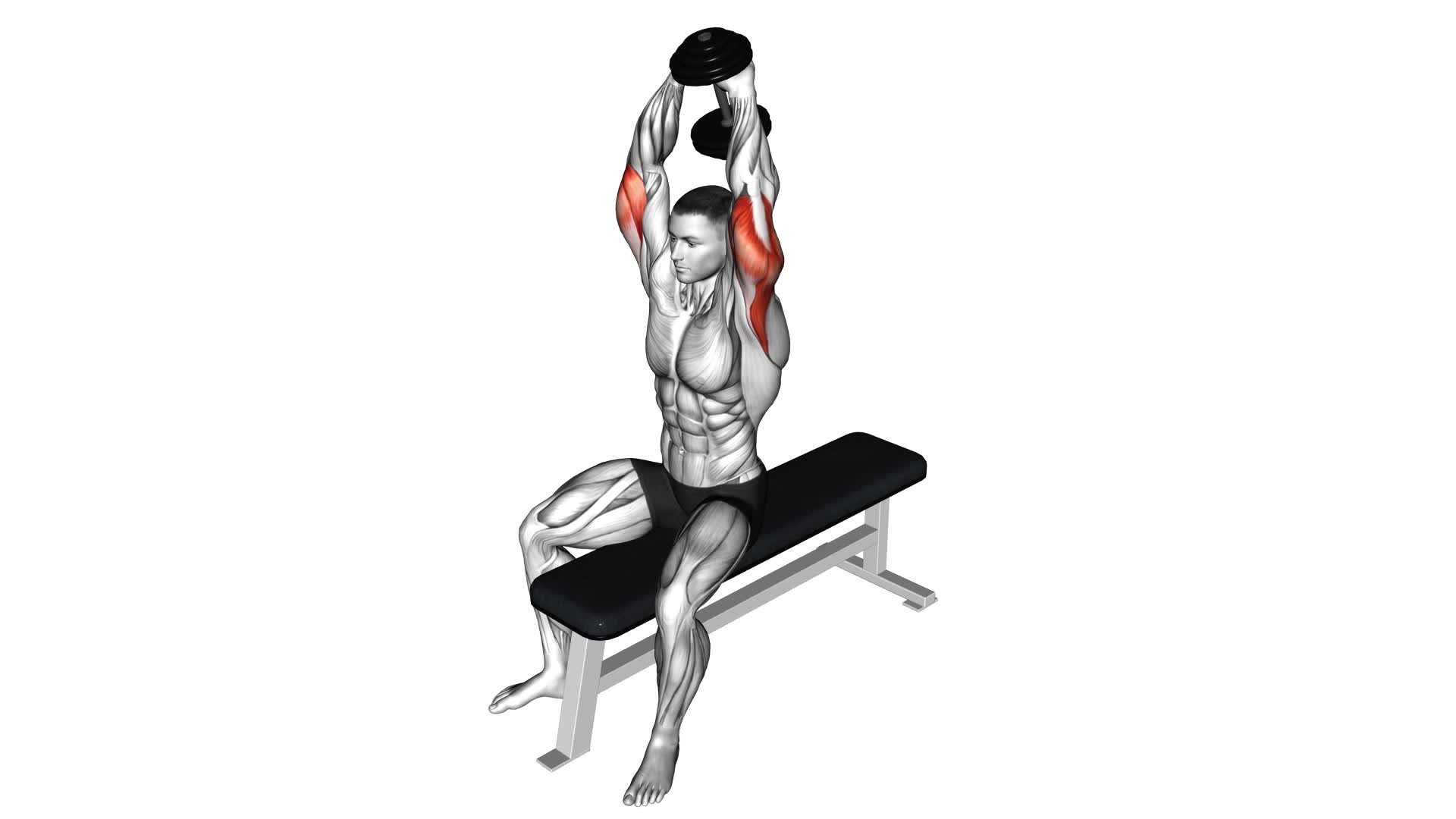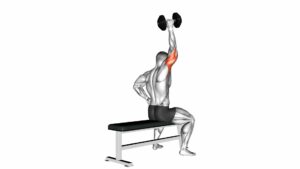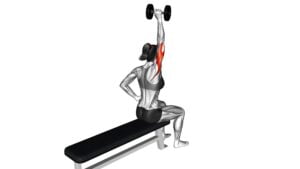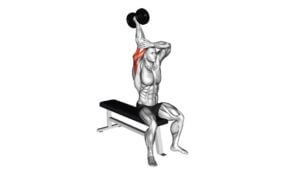Dumbbell Seated Bench Extension – Video Exercise Guide & Tips

Get ready to strengthen and tone your triceps with the Dumbbell Seated Bench Extension.
Watch This Exercise Video
This video exercise guide will show you the proper setup, correct form, and variations for progression.
Avoid common mistakes and stay safe with our expert tips and modifications.
Grab a pair of dumbbells, find a bench, and get ready to feel the burn in your arms.
Let's dive in and elevate your tricep workout to the next level!
Key Takeaways
- Proper setup and equipment are crucial for a successful dumbbell seated bench extension.
- Maintaining correct form and technique is essential, focusing on engaging the triceps and not just the chest muscles.
- Progression can be achieved through increasing weight, trying different variations, and incorporating progression options.
- Avoid common mistakes by starting with lighter weights, maintaining proper form, and being aware of potential injury risks.
Proper Setup and Equipment
To properly set up for the dumbbell seated bench extension exercise, begin by selecting an appropriate dumbbell weight and positioning yourself on a stable bench.
The importance of warm-up exercises can't be overstated. Before starting this exercise, it's crucial to warm up your muscles and prepare them for the intense workout ahead. This helps to prevent injuries and ensures that your muscles are ready to perform at their best.
Using proper equipment is also essential for a successful workout. When selecting a dumbbell weight, choose one that challenges you but still allows you to maintain proper form throughout the exercise. This will ensure that you're working your muscles effectively without risking strain or injury. Additionally, using a stable bench provides a solid foundation for the exercise and allows you to focus on engaging the targeted muscles without worrying about balance or stability.
Correct Form and Technique
Keep your back straight and shoulders down as you perform the dumbbell seated bench extension exercise. Maintaining proper form and technique is crucial to maximize the benefits of this exercise and avoid common misconceptions.
Seated bench extensions primarily target the triceps muscles, helping to strengthen and tone them. By using dumbbells, you can increase the resistance and challenge your muscles even further. This exercise also engages the shoulders and chest to a lesser extent, providing a well-rounded upper body workout.
One common misconception about seated bench extensions is that they only work the chest muscles. While the chest muscles are involved to some degree, the main focus of this exercise is on the triceps. Another misconception is that you need to use heavy weights to see results. In reality, using a weight that challenges you but still allows you to maintain proper form is more important than lifting heavy weights.
To perform the exercise correctly, start by sitting on a bench with your back straight and feet planted firmly on the ground. Hold a dumbbell in each hand, palms facing inwards. Extend your arms overhead, keeping your elbows close to your head. Slowly lower the dumbbells behind your head, bending at the elbows. Pause for a moment and then return to the starting position by extending your arms back up. Repeat for the desired number of repetitions.
Variations for Progression
If you're looking to progress the dumbbell seated bench extension exercise, there are several variations you can try. These progression options will challenge your muscles in different ways, helping you build strength and improve your overall fitness level.
One advanced technique you can incorporate is using heavier dumbbells. By increasing the weight, you'll engage your muscles more intensely, promoting muscle growth and development.
Another option is to perform the exercise on an unstable surface, such as a stability ball or a balance board. This will require your core muscles to work harder to maintain stability, enhancing your overall strength and coordination.
Additionally, you can try performing the exercise with one arm at a time, which will further challenge your stability and core strength.
Lastly, you can experiment with different grip variations, such as a neutral grip or an underhand grip, to target different muscles in your triceps.
By incorporating these progression options and advanced techniques into your dumbbell seated bench extension routine, you can continue to challenge yourself and make progress in your fitness journey.
Now, let's move on to the next section and discuss some tips for avoiding common mistakes.
Tips for Avoiding Common Mistakes
Now, let's delve into some important tips to help you avoid common mistakes while performing the dumbbell seated bench extension exercise.
To ensure proper form and prevent injury, it's crucial to be aware of the common errors that people often make during this exercise.
One common mistake is using excessive weight, which can lead to strain on the shoulder and elbow joints. It's important to start with lighter weights and gradually increase the resistance as your strength improves.
Another common error is arching the lower back during the movement. This not only reduces the effectiveness of the exercise but also puts unnecessary stress on the spine. To avoid this, engage your core muscles and maintain a neutral spine throughout the exercise.
Additionally, it's crucial to avoid locking out your elbows at the top of the movement. Locking out the elbows can lead to joint strain and increase the risk of injury. Instead, focus on maintaining a slight bend in your elbows throughout the exercise.
If you find it challenging to maintain proper form, consider using a mirror or asking a trainer for feedback. They can provide valuable insights and help you make necessary adjustments.
Safety Precautions and Modifications
To ensure a safe and effective workout, it's important to be aware of safety precautions and modifications when performing the dumbbell seated bench extension exercise. Safety should always be the top priority when engaging in any exercise routine.
When performing the dumbbell seated bench extension, it's crucial to maintain proper form and technique to prevent injury. To start, make sure the bench is stable and secure before sitting on it. Keep your back straight and core engaged throughout the exercise to protect your spine. It's also important to choose an appropriate weight that allows you to maintain control and proper form.
If you're a beginner or have any existing shoulder or back issues, it's advisable to consult with a fitness professional to determine the best modifications for your specific needs. Safety modifications can include using lighter weights, reducing the range of motion, or performing alternative exercises that target the same muscle groups.
Always listen to your body and stop immediately if you feel any pain or discomfort. Remember, safety should always come first when working out to avoid unnecessary injuries and setbacks.
Frequently Asked Questions
How Many Sets and Repetitions Should I Do for the Dumbbell Seated Bench Extension Exercise?
To get the most out of the dumbbell seated bench extension exercise, it's important to know how many sets and repetitions to do. By incorporating this exercise into your routine, you can reap a variety of benefits for your triceps and overall upper body strength.
To properly perform the exercise, it's crucial to follow the correct form and technique. So, let's dive into the benefits and proper execution of the dumbbell seated bench extension exercise.
Can I Use a Resistance Band Instead of Dumbbells for This Exercise?
Yes, you can use a resistance band as an alternative to dumbbells for the seated bench extension exercise. Using a resistance band adds variety to your workout and allows for different levels of resistance.
Resistance bands also engage your stabilizer muscles, improving overall strength and flexibility.
Additionally, resistance bands are portable and convenient, making them a great option for home workouts or when you don't have access to dumbbells.
Is It Normal to Feel a Slight Discomfort in My Triceps During This Exercise?
Feeling a slight discomfort in your triceps during the dumbbell seated bench extension is normal. This exercise specifically targets the triceps, so you should expect to feel some activation in that area.
To ensure proper form and technique, make sure you keep your elbows tucked in and close to your body throughout the movement. This will help maximize triceps engagement and minimize strain on other muscles.
Can I Incorporate This Exercise Into My Full Body Workout Routine?
Yes, you can definitely incorporate the dumbbell seated bench extension into your full body workout routine. This exercise targets your triceps and can help you build strength and definition in that area.
To modify the exercise for different fitness levels, you can adjust the weight of the dumbbells and the number of repetitions. Always start with a weight that challenges you but allows for proper form.
Remember to consult with a fitness professional for personalized guidance.
What Are Some Alternative Exercises That Target the Same Muscle Group as the Dumbbell Seated Bench Extension?
To target the same muscle group as the dumbbell seated bench extension, you can try the barbell tricep extension or the cable tricep pushdown. These exercises are great alternatives and will help you work your triceps effectively.
The barbell tricep extension focuses on your triceps while using a barbell, while the cable tricep pushdown targets the same muscles using a cable machine.
Incorporating these exercises into your workout routine will provide variety and help you achieve your fitness goals.
Conclusion
In conclusion, the dumbbell seated bench extension is a great exercise for targeting and strengthening the triceps. Make sure to set up the equipment correctly and maintain proper form to maximize results.
As you progress, try variations such as increasing weight or using different grips. Remember to avoid common mistakes and prioritize safety by using proper form and modifications if needed.
With consistent practice, this exercise can help improve triceps strength and overall upper body fitness.

Author
Years ago, the spark of my life’s passion ignited in my mind the moment I stepped into the local gym for the first time. The inaugural bead of perspiration, the initial endeavor, the very first surge of endorphins, and a sense of pride that washed over me post-workout marked the beginning of my deep-seated interest in strength sports, fitness, and sports nutrition. This very curiosity blossomed rapidly into a profound fascination, propelling me to earn a Master’s degree in Physical Education from the Academy of Physical Education in Krakow, followed by a Sports Manager diploma from the Jagiellonian University. My journey of growth led me to gain more specialized qualifications, such as being a certified personal trainer with a focus on sports dietetics, a lifeguard, and an instructor for wellness and corrective gymnastics. Theoretical knowledge paired seamlessly with practical experience, reinforcing my belief that the transformation of individuals under my guidance was also a reflection of my personal growth. This belief holds true even today. Each day, I strive to push the boundaries and explore new realms. These realms gently elevate me to greater heights. The unique combination of passion for my field and the continuous quest for growth fuels my drive to break new ground.







